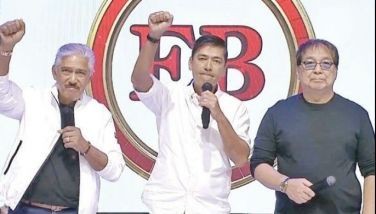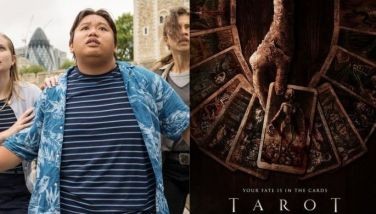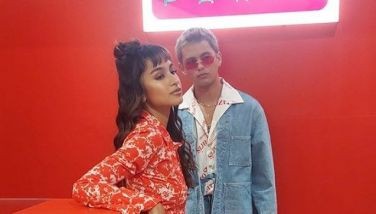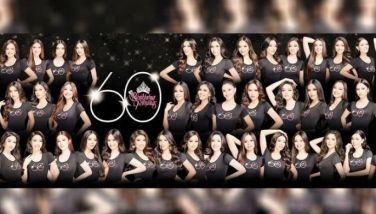So that’s what makes Dolphy tick!
August 6, 2001 | 12:00am
 During the Philippine Centennial celebration in 1998, a publication asked its readers to send in what they considered to be the 100 best things about being Filipino. I whipped out my pen and quickly made my list, which included Fernando Amorsolo paintings, succulent golden mangoes, Sampaguita movies, kapeng barako, close family ties, Noli Me Tangere, Kenkoy strips. Among the very first names I wrote was " Dolphy".
During the Philippine Centennial celebration in 1998, a publication asked its readers to send in what they considered to be the 100 best things about being Filipino. I whipped out my pen and quickly made my list, which included Fernando Amorsolo paintings, succulent golden mangoes, Sampaguita movies, kapeng barako, close family ties, Noli Me Tangere, Kenkoy strips. Among the very first names I wrote was " Dolphy".
That was because, for as long as I could remember, there wasn’t a time in my life when Dolphy wasn’t there. Even as a tot, I would snuggle by my mom as she watched black and white TV, laughing her head off as Dolphy "mangled" his "translations" of English songs in Buhay Artista.
Then came John en Marsha, which became a habit I pretty well kept from my elementary through my college years. Though more studies and then work kept me from following Gabi ni Dolphy and Home Along Da Riles, I’d still watch from time to time, along with Dolphy movies, whether shown in theaters or re-shown on TV (my favorites are Baboy Kural, Tarsan vs. Tansan and the John en Marsha movies).
Time flew quickly and then last week I chanced upon Pidol Power (40 to Forever), the Dolphy special that celebrated the comedian’s 40 years in Philippine television. "It’s about time!" was the first thing I found myself saying.
Sometimes we take the presence of veteran entertainers for granted simply because they’ve been around for so long. And then comes a special like this and we remember how much they’ve contributed and how thankful we should be. Perhaps the success of this special will move our TV producers to come up with similar shows (not necessarily musicales but say, retrospectives) for Philippine entertainment’s other treasures like Fernando Poe, Jr. perhaps, or Gloria Romero or Vilma Santos.
Produced by Dolphy’s partner Zsa Zsa Padilla, the show, which took three months to complete, featured clips both from Dolphy’s past TV shows and films – a truly welcome nostalgic trip down memory lane. Even in these brief clips, one could appreciate how huge a swath Dolphy has cut not just in Philippine showbiz but in Filipino culture. On TV alone, he has regaled the generation weaned on black and white TV to those of the digital computer age.
Whether mirroring the way the Filipino common man struggles as John Puruntong or Kevin Cosme, or reflecting the travails of the Filipino gay (or I would like to think, of Filipino outcasts in general) as Facifica Falayfay, Dolphy succeeded not just in drawing laughs (which other comedians may well easily boast of ) but in conveying a quiet dignity, an irrepressible humor and a sense of "I will not be overcome", that are quintessential Filipino traits. These, Dolphy captured in a way that no comedian has – which is probably why we Filipinos have "connected" or identified with his characters through an astonishingly long half a century.
The clips also amply displayed Dolphy’s brand of humor–light, breezy very un-OA ("over-acting"), playful, naughty, but never ever vulgar, even if he has resorted to toilet humor many times. Oftentimes when I watch today’s comedians – whether in noontime shows or in the movies – I am aghast at how vulgarity (sexual innuendoes, profane language and lewd jokes) seems to be the norm.
Dolphy has proven that one doesn’t need vulgar comic antics to succeed. Why don’t the younger comedians take their cue? Vulgarity after all, is a cop-out of sorts; it is laziness trying to pass itself off as funny. It takes a certain level of intelligence and sensitivity to cull and make humorous light of material from everyday circumstance, and this, Dolphy has in abundance.
Pidol Power also featured tributes or performance from virtually all the stars in Philippine showbiz who matter (Jolina Magdangal, Jericho Rosales,Regine Velasquez, Pops Fernandez, etc.), and a Moulin Rouge production number joined in by Vandolph, Epi and Boy 2 Quizon in drag. It turns out that Dolphy has not only contributed a career, but talented entertainer-offspring, to Philippine showbiz.
I appreciated it that the show also featured clips showing Dolphy ( with Gary Valenciano, Vilma Santos, Alma Moreno) in all his terpsichorean glory. Dolphy has always been proud of his vaudeville roots, and his lightness and grace as a dancer reflect this all too well. I think that a large measure of Dolphy’s "durability"– unlike flash-in the-pan comedians – is that he is an entertainer through and through. A dancer, a singer, an actor, he has a wealth of other talents to tap either for enhancing laughs or use in between the laughs.
The most touching part of the musical extravaganza for me was when Dolphy paid tribute to his late co-stars. I still remember them well: his loyal sidekick and foil, Panchito; the "asthmatic " Bayani Casimiro (how I loved his tap-dancing showdowns with Dolphy!); Ading Fernando who also directed Dolphy in John en Marsha: and the lovably irascible Babalu. I am sure Dolphy would agree in saying that these guys brought out the best in him as a comedian.
As a whole, Pidol Power (40 to Forever) afforded viewers the chance to marvel at the length and breadth, the sheer scope of one remarkable Filipino entertainer’s career. If the heavy commercial load was any indication, the well-loved comedian is still a force to reckon with even in this new millennium.
So glad to still have you with us, Dolphy. Here’s to forever!
BrandSpace Articles
<
>
- Latest
- Trending
Trending
Latest
Trending
Latest
Recommended

























 Exclusive
Exclusive


